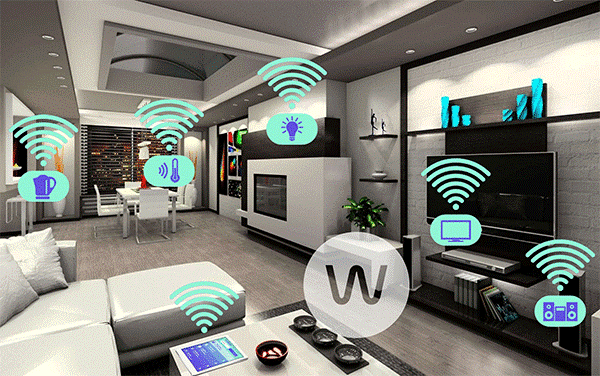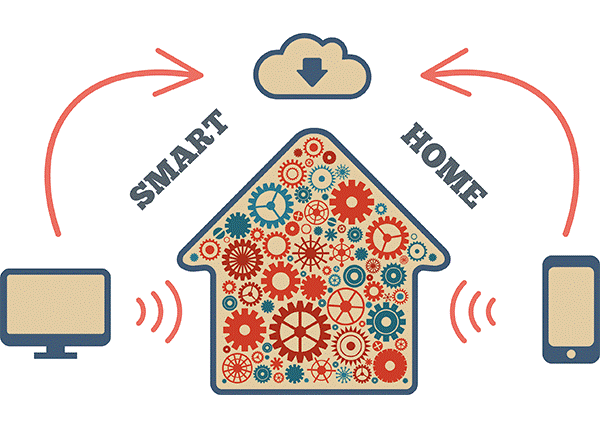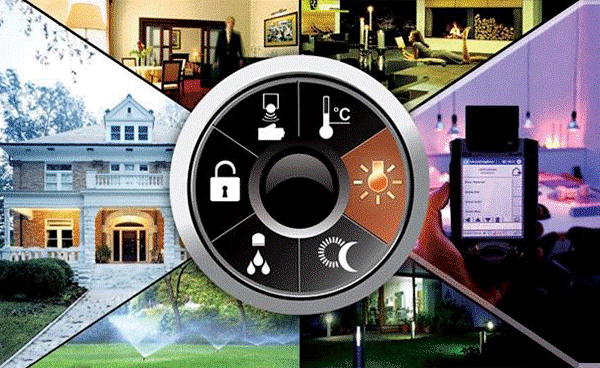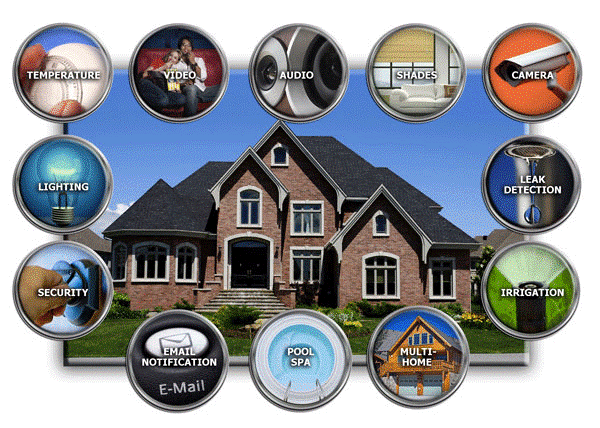Introduction
We use so many appliances at home that often it becomes a headache to keep track as to whether everything is switched off or not, especially after stepping out of the house. Home automation or smart home is a key that keeps you away from all these worries by automating the appliances and connecting them to a common network. It is basically a home where everything including the lights, alarm clocks, television, doors, windows, blinds, heating and cooling systems can talk to each other. Not only this, all such automated devices also receive as well as interpret their owner’ instructions and then behave accordingly.

Figure 1: Home Automation Technology
The success of home automation, to some extent, relies on the availability of smartphones as they can be easily connected to other devices through the internet and are highly portable. The concept makes use of Internet of Things technology that integrates objects with the internet, thereby linking them all to a common connection that can be controlled by the user. It is speculated that the home automation industry could witness highly favourable sales figures in the upcoming years.
Home Automation Technology

Figure 2: Smart Home
The two main constituents of a smart home are -:
Automation: It refers to the ability to schedule the events beforehand so that the device learns to perform certain activities at that particular time on a daily basis. For example, every night when you go to sleep the lights are turned off on their own. It may also include rare incidents like turning the lights on whenever the alarm is triggered.
Remote Control: Home automation makes use of monitoring apps which can be accessed through your smartphone or tablet. Such apps give information in the form of live feed or one can program the same to get notifications in the form of emails or text messages in case there is a potential security threat or any other problem.
Home Automation Associated Terms
The foundation of home automation technology is based on some important elements which form the whole setup of hardware and software required in building a smart home. Let’s take a look at some important terms.
X10: It’s a protocol which enables communication among the devices used for home automation. Developed by Pico Electronics in 1975, it allows remote control of devices and appliances which act as receivers while the keypads and other means act as transmitters.
Although there are numerous X10 devices using electrical wires, some new systems have also been developed which use radio waves to communicate. Two important radio networks of home automation are listed below.

Figure 3: Home Automation Protocol
Z-Wave: In this, each device is embedded with a code and when it is plugged, the controller recognizes the code and adds it to the network after determining the location. There is a hierarchy among the devices and the fastest route is chosen to transmit a message.
ZigBee: It uses mesh networking concept where messages travel in a zigzag manner determining the best path to reach the receiver. The platform is based on the standard set by IEEE (Institute of Electrical and Electronics Engineers) for wireless personal networks. This implies that any company can build a Zig-Bee compatible device without paying any license fee.
Insteon: This technology integrates both radio waves and electrical signals to form a dual-mesh network. Instead of routing, the message is broadcasted by all the devices until the command is implemented. There is no hierarchy and hence all the devices act like peers.
Smart Home Set Up

Figure 4: Home Automation Setup
Setting up of a smart home requires the fundamental technology including protocols and all the hardware and software. Besides, you need smart devices that can be connected to the internet on the home network. For example, cameras, motion sensors, LED lights, devices with built-in web servers, etc. These are readily available online or at electronics improvement stores.
Before buying such products, one has to make sure that all devices use the same technology. If two devices use different technologies, say one uses X10 while other uses Z-Wave, then it requires a bridging device as well as a lot of technical expertise. It is usually recommended that one should seek professional help while designing a smart home. Technicians with CEA-Comp TIA Certification are considered to be more proficient in installing and troubleshooting the home networking equipment.
The cost of home automation depends on how smart the home is. The users can either keep it basic with jut intelligent lighting or add high-tech security systems. One has to decide where to place the nodes to have an effective routing range and plan the as it may require renovation or rebuilding of certain portions of the house.
Benefits of Smart Home

Figure 5: Smart Home Benefits
A smart home makes life easier by imparting the ability to control the appliances remotely, irrespective of your location. It can switch on the TV program of your choice at a fixed time, make coffee for you, and set the lightings as per your mood and so on. However, there are many more important ways in which this technology is helpful. When you wake up in the dark and visit the bathroom, it’s intelligent enough to light up the path. In case, the fire alarm buzzes, it can be even programmed to unlock the doors and make a call to the fire department.
Besides, it also saves electricity and brings down the bills by sensing the presence of residents in a house and turns off the appliances when not in use. Such things can be specifically useful for elderly people who live alone and their children can monitor the house even while staying away from the house. In a nutshell, a smart home never lets you feel alone and takes care of everything that you wish for.
Challenges
It’s quite a well-known fact that home automation is still limited to a few household because of its high cost and complexity. There are certain reasons because of which smart homes are not quite the main stream. The most basic obstacle is people’s ability and knowledge to handle and comprehend the technicality of the system. It’s not as simple as it seems. One should know how to operate and set the device so that it works as per the demands because no device can work without instructions.
Secondly, there is still not a standard system for home automation and hence people are reluctant to invest a huge amount of money for something about which they are unsure. Many think of it as a concept that may not flourish for long. Moreover, since everything is automated, a smart home is subject to a lot of risk of being hacked allowing intruders to break-in. Once hacked, the whole control would be handed over to the hacker and then even the owner would lose access to his/her own house.
Some Popular Home Automation Products

Figure 6: Smart Home Products
Owing to the technicalities, the market for home automation products is not operating at its full swing. However, the large-scale availability of smartphones and tablets can help even the tech novices to download apps and then automate any device they want. Listed below are some popular and commonly used smart home products that are easy to setup.
Nest Thermostat
It comes integrated with WiFi that enables the user to monitor the temperature of the house remotely, irrespective of your location. It can even learn your behaviour and set the temperature on its own. In addition, it has the capability to remind you about the amount of energy being used by your device and remind you to change the filters.
WeMo Switches
The WeMo home automation switches are accompanied by a switch and motion detector all at the cost of just around USD100. You simply have to plug the WeMo switch to the outlet and the plug the device to the switch. After downloading the Belkin app, you’ll be able to remotely control the connected device, say, turn on or turn off the lights.
Philips Hue Lights
The starter pack worth USD 200 comes with three LED bulbs and a bridge. Once these are fixed, the app on your smartphone connects to the lights and then you can perform several tasks like changing the brightness and color of the bulbs.
Amazon Echo
Amazon Echo is a Bluetooth speaker with a built-in voice control assistant called Alexa. It answers questions much like Siri (iPhone) and also performs various tasks on the user’s command. It stands at 9.25 inches in length and 3.27 inches broad and can be availed at around USD 180.
Conclusion
Despite all the technological advancements and innovative products, there is a constant mental conflict as to how important it is to automate everything around us. The question is, do we really need smart homes? Although it’s less about convenience and more about home security, yet the most basic things always start with handing over the work (that we can easily do) to machines.
However, aspects like house security and fire detection are some crucial factors that justify the use of home automation to a great extent. Simply put, it’s us who have to decide how smart our home is and that whether we need it as a companion or just a slave who follows commands.
You may read our Blog and Article section for more topics on electronics engineering, industry, and technology.
Filed Under: ARM., Tech Articles


Questions related to this article?
👉Ask and discuss on Electro-Tech-Online.com and EDAboard.com forums.
Tell Us What You Think!!
You must be logged in to post a comment.